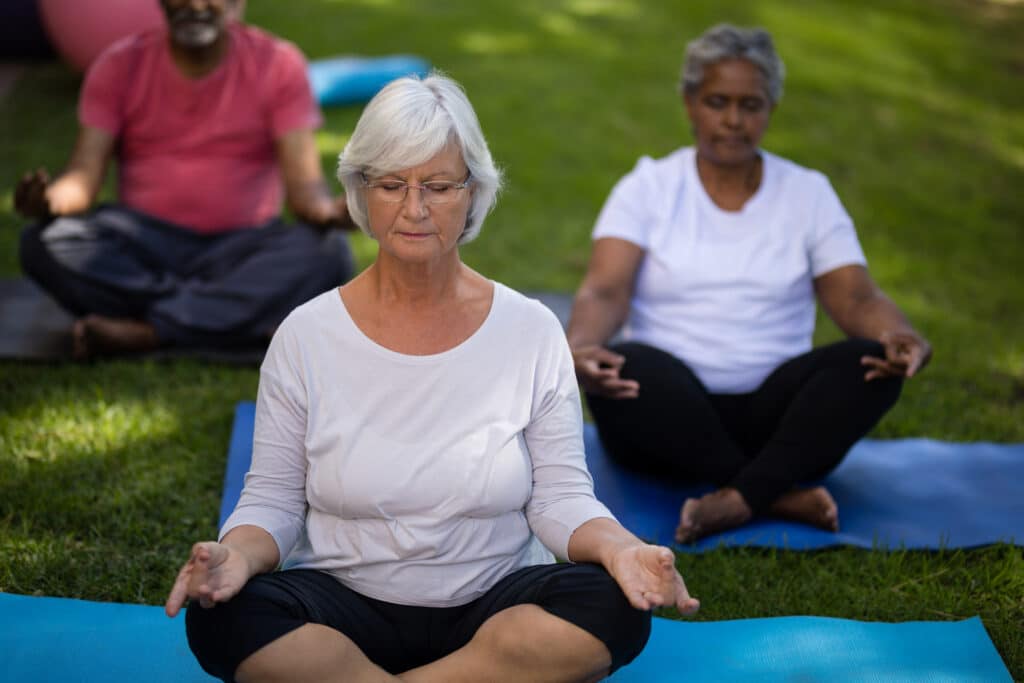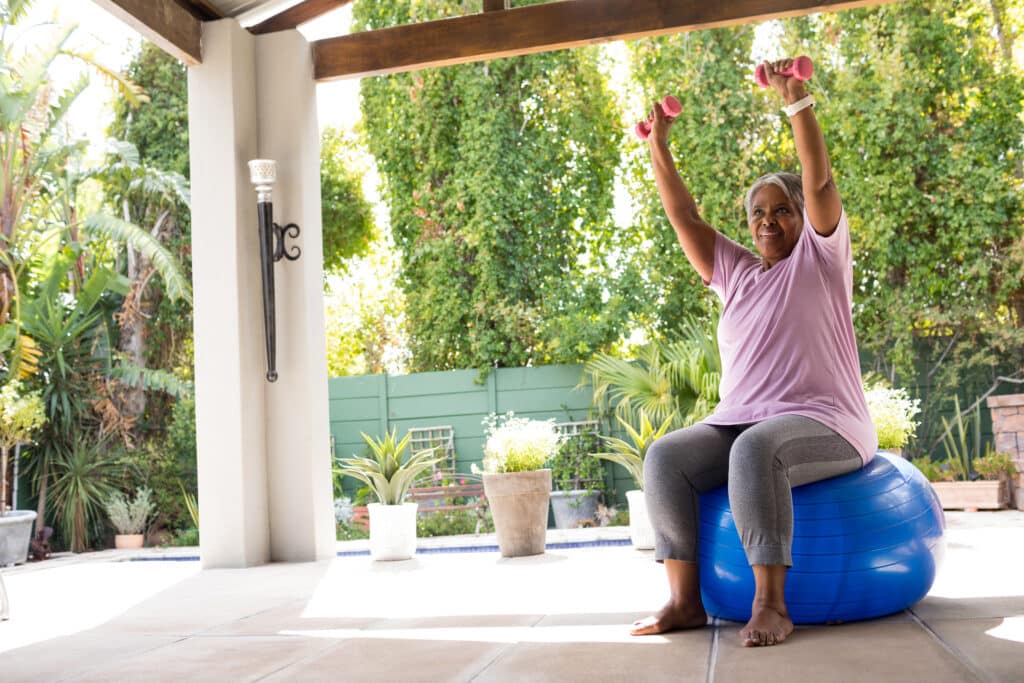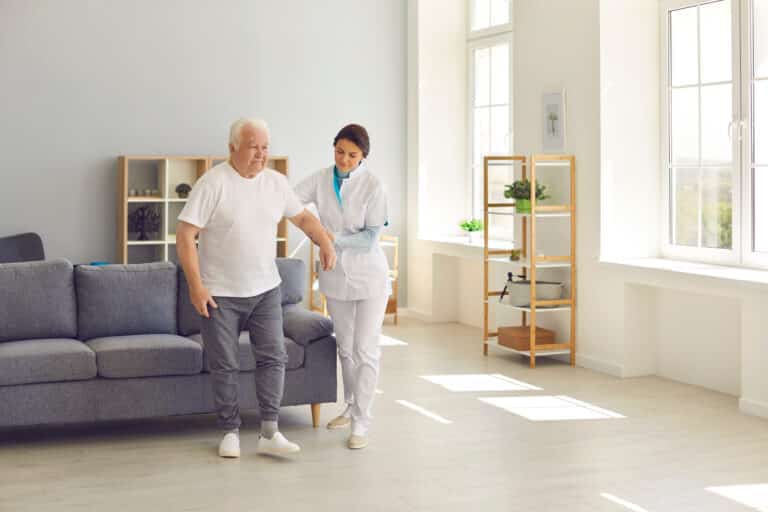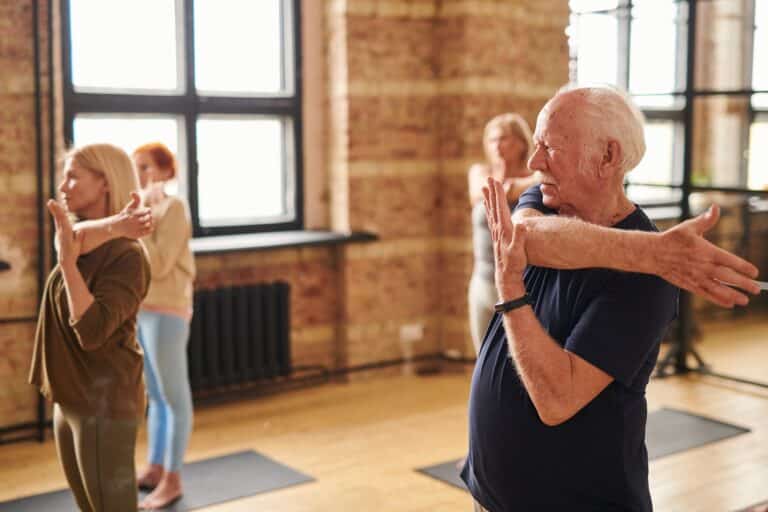As we age, it’s natural for our bodies to undergo changes, and sometimes, we may become more susceptible to various health issues. A hallmark example of this is Parkinson’s disease, which significantly affects the lives of millions every day.
However, it’s important to remember that we are not helpless against Parkinson’s disease. By adopting the proper self-care techniques, you can better manage the symptoms of Parkinson’s and live a more satisfying life even after a diagnosis.
Having helped many older adults who have Parkinson’s disease in my physical therapy practice, I would like to provide you with practical advice and exercises that can aid in your journey with Parkinson’s disease.
In this article, I’ll cut through the complicated medical terminology and look at the simple, day-to-day steps you can take for Parkinson’s disease self-care to enhance your mobility, alleviate pain, and prevent further complications.
What is “Self-Care,” and Why is it Important for Parkinson’s Disease?
While we often put a lot of weight into seeing your doctor and going to appointments, a lot of Parkinson’s management happens at home through thoughtful and consistent self-care. This is one of the most essential tips for living with Parkinson’s disease in general.
Self-care is far more than a trendy buzzword, but understanding the ins and outs of self-care is the first step to a better quality of life.
Defining Self-Care
In its simplest form, self-care means taking active steps to preserve or improve your health.1
Unlike passive treatments like implants or surgery, self-care focuses on active participation from the patient — that means you!
Self-care encompasses physical, mental, and emotional well-being practices beyond basics like eating healthy or exercising regularly. It includes activities that help us manage stress, foster positive self-esteem, maintain healthy relationships, and stimulate our brains.1
One good example of Parkinson’s disease self-care modifications is physical therapy at home. Although I work with my patients in the clinic, I also provide home exercise programs to work on when they don’t have appointments with me.
We’ll touch on physical therapy and exercise throughout this article, but let’s look at how these practices can specifically benefit Parkinson’s patients.
Understanding Self-Care for Parkinson’s Disease
When it comes to managing Parkinson’s disease, self-care takes on a whole new level of significance. This neurological condition, which affects motor skills (how your body works) and cognitive function (how your brain works), can be challenging. Incorporating a robust self-care routine can help you handle these challenges more effectively.
Studies suggest that self-care behaviors can significantly reduce stress, improve mood, and enhance the overall quality of life for those with Parkinson’s disease. It’s not a cure, but it can make living with the condition more manageable.2
Many of the older adults that I have worked with benefit from a collection of Parkinson’s disease self-care modifications recommended by their care team.
For example, your physical therapist may recommend exercises to perform at home. At the same time, your primary care doctor may have tips on the best times and methods to take your medication. Self-care is a highly personalized practice. Knowing where you could use some extra care, and having a robust set of tools and support makes all the difference.
Practical Self-Care Activities

Like any new concept, it helps to have some examples of what self-care can look like for Parkinson’s disease. Here are a few examples of self-care habits that many older adults can benefit from.
Nutritional Balance – Eating a balanced diet rich in fruits, vegetables, lean proteins, and whole grains can provide nutrients for better body and brain function.
Hydration – Drinking enough water is crucial for overall health, including optimal muscle function, brain function, and digestion.
Sleep Hygiene – Getting enough restorative sleep can help reduce fatigue and improve cognitive function, vital when living with Parkinson’s disease.
Medication Management – Regularly taking prescribed medications, such as levodopa, helps manage symptoms and may even slow disease progression. Managing medication is one of the most important self-care practices for many older adults.
Relaxation Techniques – Activities like yoga, tai chi, meditation, or deep-breathing exercises can help reduce stress levels and improve your well-being.
Social Interaction – Connecting with friends, family, or support groups can boost your mood and provide emotional support through hard times.
Hobbies – Pursuing enjoyable activities can provide mental stimulation and reduce feelings of isolation, a common issue for those with Parkinson’s disease.
The Real Value of Self-Care
It’s important to note that self-care isn’t about self-indulgence or being selfish. It’s about acknowledging your needs and taking steps to meet them.
In fact, a more productive way to think about self-care is taking care of yourself in a way that enables you to care for others better. It’s a necessary and beneficial part of living with Parkinson’s disease.
Outside of the most essential medical treatments, self-care can be your most powerful tool for managing Parkinson’s disease long-term. More importantly, good self-care can help you feel more in control of your health to improve your quality of life.
It’s not about quick fixes but about creating sustainable, healthy habits that support your wellbeing in the long term. Remember, your self-care routine is personal to you. What works for one person may not work for another. So, find what makes you feel good, and make it a part of your daily routine.
Creating Your Personalized Self-Care Plan for Parkinson’s Disease
Living with Parkinson’s disease presents a unique set of challenges. However, with a personalized self-care plan, you can navigate your journey more easily and confidently.
Here’s a step-by-step guide on creating a self-care plan for Parkinson’s that resonates with your needs, preferences, and goals.
Assess Your Current Situation
Understanding your health status is the first step in crafting a self-care plan. This involves understanding your symptoms, accepting their impact on your daily life, and identifying areas where you need improvement. These factors could be related to movement, mental health, or social interactions. Remember, this is not a time for self-judgment but for self-awareness.
In most cases, you’ll want the help of friends, family, or your care team to thoughtfully assess your current situation and where there is room for improvement. As a physical therapist, I’ve helped many older adults with Parkinson’s realize how particular issues might be affecting their day-to-day lives.
Get Serious About Managing Stress
Incorporating stress management into your Parkinson’s self-care plan is crucial, as stress can exacerbate symptoms and impact overall well-being. Start by identifying your stress triggers, whether they’re related to daily activities, medication schedules, or social interactions.
Experiment with stress-reduction techniques such as deep breathing, meditation, gentle yoga, or tai chi. Mindfulness practices can further aid in managing stress by encouraging presence and acceptance of the current moment without judgment.
Additionally, don’t underestimate the value of professional support in navigating stress. Cognitive-behavioral therapy (CBT) and other talking therapies can offer tailored strategies to cope with the emotional challenges of Parkinson’s.
Regularly reassess your stress management techniques and be willing to adjust your strategies as needed, ensuring they remain effective as your condition evolves. This approach to stress management will support your physical, emotional, and psychological health, enhancing your overall quality of life.
Set Realistic and Specific Goals
Once you clearly understand your current situation and your stress level, it’s time to set some goals. Be sure they’re realistic and specific. For instance, rather than saying, “I want to move more,” you might say, “I want to walk for 15 minutes daily.” This gives you a clear target and makes it easier to track your progress.
Of all the helpful tips for living with Parkinson’s disease, this might be the most important one. Getting there is much more realistic if you know where you’re going!
Choose Enjoyable and Accessible Self-Care Activities
Self-care should feel like a smooth process. Choose activities that you enjoy and that are meaningful to you. This could be anything from gardening and painting to dancing. The key is choosing something accessible to you and aligns with your interests.
Given your current health status, it almost always makes the most sense to focus on your favorite activities and learn to make them as approachable as possible. If something still seems out of reach, it’s an excellent opportunity to think about some specific goals that will help you get there.
Schedule Self-Care Time and Stick to a Routine
Consistency is critical when it comes to self-care. Decide on specific times for your self-care activities and stick to them as much as possible. Treat this time as non-negotiable, like a doctor’s appointment or an important family event.
While consistency is key, rest days are important too – in fact, this is one of the most important things I teach my patients. If you’re feeling overwhelmed or exhausted, it’s okay to focus only on the most essential parts of your self-care routine and then try to get back to your full routine the following day.
Seek Support and Guidance
Remember, you’re not alone on this journey. Reach out to others for support when you need it. This could be family, friends, your care team, or even Parkinson’s support groups with other people who are going through similar experiences.
Plenty of resources are available to help you along your journey with Parkinson’s. For instance, both the Parkinson’s Foundation and the American Parkinson’s Disease Foundation provide a selection of resources and helpful self-care tips.
Remember, your self-care plan will be unique to you. What works for one person might not work for another. It’s all about finding what suits you best and dedicating time to care for your physical, emotional, and social wellbeing. With a personalized self-care plan, you can enhance your quality of life, manage your symptoms better, and navigate your Parkinson’s journey more confidently.
How to Incorporate Home Exercises into Your Self-Care Routine

Home exercises are more than just a part of self-care; they are essential in managing Parkinson’s disease. A good exercise plan can significantly improve mobility, strength, balance, coordination, flexibility, and endurance.3
But what exercises are best for those with Parkinson’s? And how can you safely incorporate them into your routine?
As a physical therapist passionate about using exercise to improve health, wellbeing, and quality of life, I’ll share some of the most important things to know about exercise in Parkinson’s disease self-care.
The Power of Stretching
Stretching exercises are an effective way to ease muscle stiffness and improve your range of motion. These can be as simple as extending your arms above your head or reaching for your toes. You might be surprised how these small movements can make a big difference in your comfort and mobility.
Many older adults with Parkinson’s disease benefit from stretching because it helps counteract and relieve some of the tension that builds up in muscles due to rigidity, a type of muscle tone that develops with Parkinson’s. Being diligent about stretching can mean maintaining mobility and joint health for longer.
Aerobic Exercises for Cardiovascular Health
Aerobic exercises, such as brisk walking or cycling, boost your cardiovascular health and also help reduce fatigue. A report by the Parkinson’s Foundation showed that regular aerobic exercise significantly improves health status in adults with Parkinson’s disease, including motor skills and mood.4
In practical terms, an example might be going on a 20-minute walk every morning, purchasing a stationary exercise bike for your home, attending a Parkinson’s fitness class, or even all three. Making your heart and lungs work harder by increasing your heart and breathing rate should be the priority with aerobics.
Resistance and Balance Exercises for Strength and Stability
Resistance exercises like lifting light weights or using resistance bands can help build muscle mass and prevent weakening your bones and joints. Balance exercises, on the other hand, can prevent falls and enhance stability. This could be as simple as standing on one foot, walking heel to toe, or trying out Parkinson’s specific strength and balance classes.
Even without gym equipment, you can practice resistance exercises using your body weight at home. Your physical therapist or trained Parkinson’s disease exercise specialist can help you learn the best exercises that are safe to practice at home.
In most cases, balance exercises should be done with supervision for safety.
Functional Exercises for Independence
Functional exercises focus on improving daily activities and independence. This can be as straightforward as practicing standing up from a chair or picking up objects from the floor. These exercises can drastically improve your quality of life and make everyday tasks less challenging.
Guidelines and Precautions for Home Exercises
Before starting any exercise program, consulting with a physical therapist or doctor is essential. They can help you choose exercises that match your abilities and limitations. Remember to warm up and cool down properly to prepare your body for the workout and reduce the risk of injury.
More importantly, always listen to your body. If any exercise causes pain or discomfort, stop and reassess. Modify the exercise or ask someone else for help if you feel unsure.
Useful Resources for Your Journey
For more information on exercises suitable for older adults with Parkinson’s disease, check out the Parkinson’s Foundation’s Fitness Counts program, the Brian Grant Foundation’s Exercise for Parkinson’s, and the Davis Phinney Foundation’s Exercise Essentials for Parkinson’s Disease. These resources provide helpful guides and instructions on how to perform exercises safely for Parkinson’s disease self-care.
Incorporating home exercises into your self-care routine can have a significant impact on managing Parkinson’s disease. Find the exercises that work best for you and make them a part of your daily routine. Your body will thank you!
Key Takeaways
- Self-care is essential for managing Parkinson’s disease, encompassing physical, mental, and emotional well-being.
- Identifying stress triggers and employing stress-reduction techniques can significantly enhance quality of life.
- Setting realistic, specific goals and engaging in enjoyable, accessible activities promote sustained self-care.
- Consistency in self-care routines and flexibility to adjust strategies are crucial for effective symptom management.
- Professional support and resources from the Parkinson’s Foundation offer valuable guidance and support.
- Incorporating a range of home exercises tailored to individual abilities can improve mobility, strength, and overall health.
- Listening to one’s body and consulting with healthcare professionals before starting any exercise regimen is essential to ensure safety and efficacy.
Summary
This article distills my clinical experience as a physical therapist with tips and insights into a practical care routine designed to empower those with Parkinson’s. By advocating for an approach rooted in self-awareness, goal-setting, and the integration of enjoyable activities, I aim to illuminate a path toward enhanced well-being despite the disease’s challenges. Stress management, a consistent routine, and community support are pivotal components of this journey. Moreover, I emphasize the crucial role of home exercises—stretching, aerobic activities, resistance training, balance, and functional exercises—in maintaining and improving physical function. My goal is to offer a blueprint that not only addresses the physical symptoms of Parkinson’s but also nurtures the emotional and psychological aspects, ensuring a holistic approach to managing the condition. With the right strategies, resources, and support, living a fulfilling life with Parkinson’s is within reach.
References
- What is Self-Care? Global Self-Care Federation.
- Milne-Ives M, Carroll C, Meinert E. Self-management Interventions for People With Parkinson Disease: Scoping Review. J Med Internet Res. 2022 Aug 5;24(8):e40181. doi: 10.2196/40181. PMID: 35930315; PMCID: PMC9391969.
- Fayyaz M, Jaffery SS, Anwer F, Zil-E-Ali A, Anjum I. The Effect of Physical Activity in Parkinson’s Disease: A Mini-Review. Cureus. 2018 Jul 18;10(7):e2995. doi: 10.7759/cureus.2995. PMID: 30245949; PMCID: PMC6143369.
- Aerobic Exercise Positively Alters Parkinson’s Brain. Parkinson’s Foundation.






